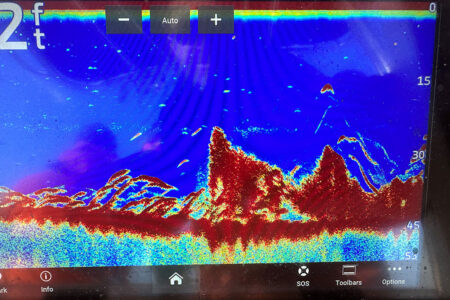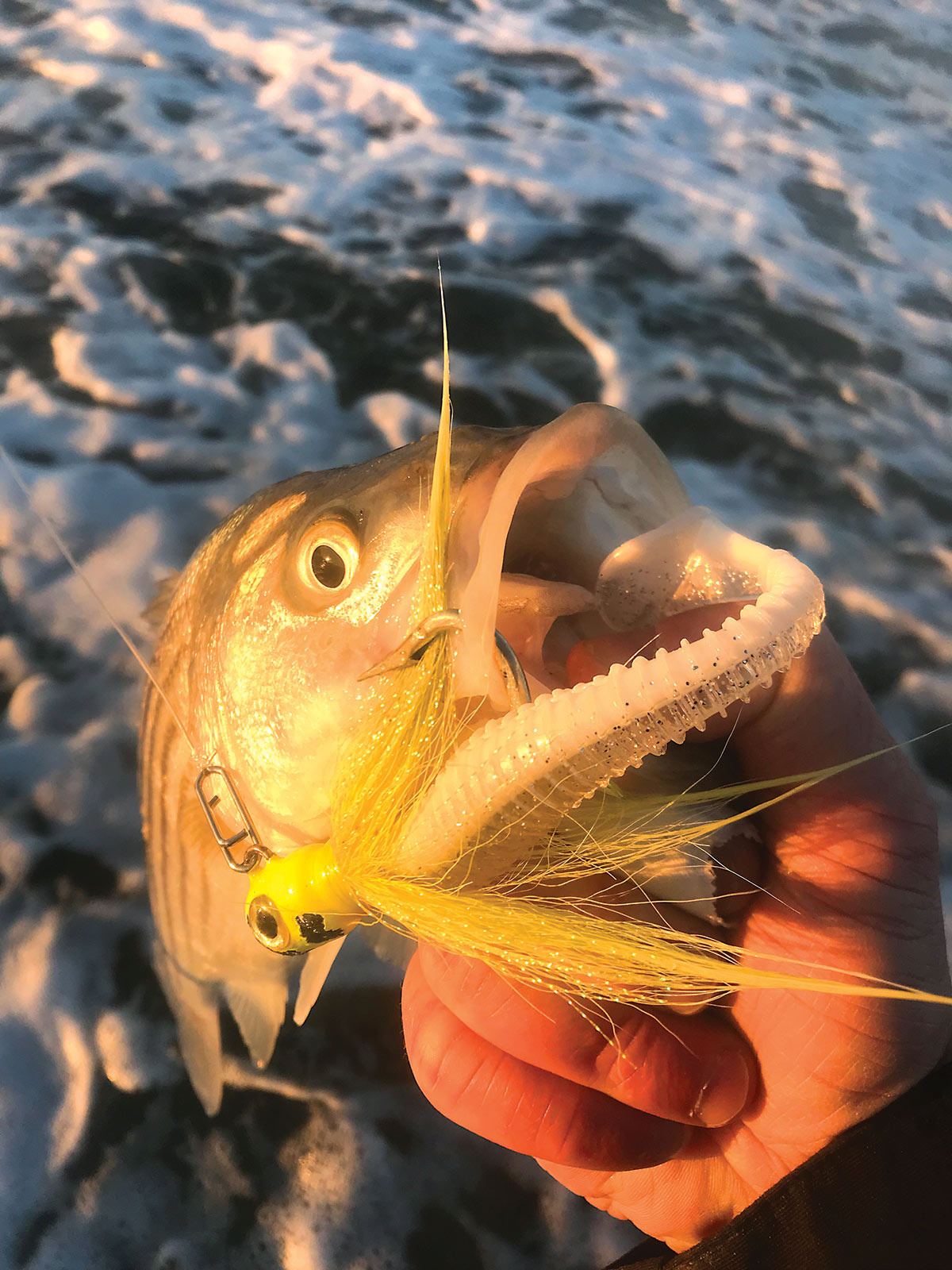
As kids my buddies and I would bicycle about 5 miles away to the next town to fish the local country club lake for pickerel and bluegills. Growing up fishing the docks for snapper bluefish, it was fun tangling with chainsides on light tackle outfits from time to time, as the fish were more than willing to whack at all types of spoons and spinners.
And then came that fateful morning when we’d finally sighted our first monster largemouth prowling the edge of the weed beds; it was like catching a glimpse of Sasquatch or the Jersey Devil himself.
We spent days bicycling from shop to shop in search of largemouth lures, a somewhat difficult prospect in a small coastal town in the 1970s. We’d eventually throw everything we could find that was fresh looking along those weed beds, but to no avail. Then my parents helped me make my initial foray into mail order purchasing, a weedless rubber frog I saw in the back of a fishing magazine.
For the life of me, I can’t remember what company made that soft rubber bait with the up-turned hooks, but it worked! Pretty soon we had begun to experiment with other “new fad” lures like buzz baits and Jitterbugs; as kids who grew up throwing hooked natural baits into nearby Barnegat Bay, this was pretty groundbreaking stuff.
That’s not to say it was groundbreaking for other more experienced anglers. Not long after this lakeside epiphany, my grandfather introduced me to the local weakfish sharpie next door; looking for a little advice for fishing the local jetties, he gave me a Mann’s purple Jelly Worm and white bucktail, a virtual sea trout killer at the Jersey Shore in the ‘70s and ‘80s. Unbeknownst at the time, I was in the process of making my first “crossover” from the world of fresh to salt in terms of tackle selection.
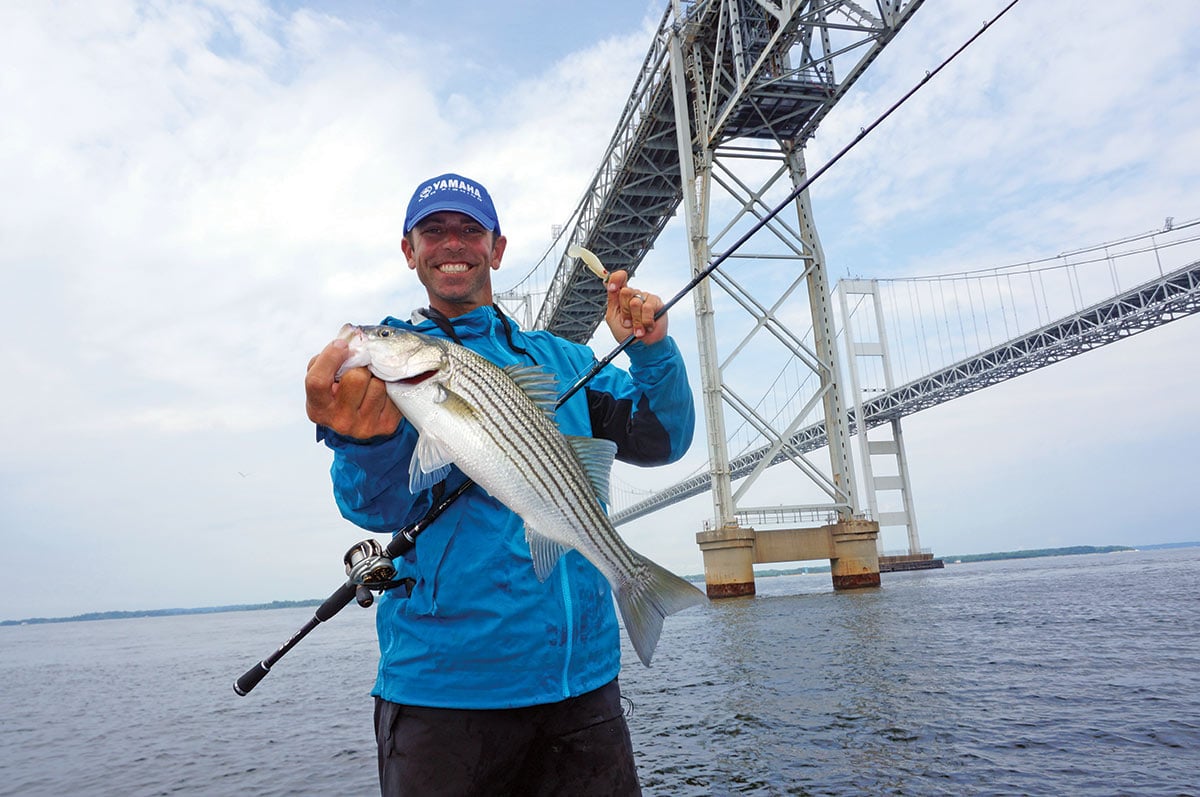
The Worm Keeps Turning
Effective for hawgs and tiderunners alike, the soft plastic worm is said to have gotten its start by Nick Creme in 1949. According to the Arkansas based Bass Hall of Fame, the Creme Lure Company began in Ohio when Nick and his wife Cosma used a combination of vinyl, oils and pigments to produce a molded worm first sold by mail order as the Creme Wiggle Worm. Interestingly enough, Creme would go on to become one of the first companies to sponsor a bass professional when they paid angler John Powell $18K a year to fish Creme Scoundrels and Shimmy Gals.
The same year Powell got his sponsorship deal, Tom Mann first introduced his Jelly Worm, 1967. “Tom was experimenting on stove top with different types of plastics and additives to create a plastic worm and actually got the notion to add some jellied preserves to a batch one day and the smell gave him the light bulb effect,” said Scott Wall at Mann’s Bait Company. “The fruit scent not only attracted the attention of anyone near a bag of the baits, but it was also touted by Tom Mann as being a good human-sent mask.” In terms of pro bassers, Wall said this was the worm that helped Paul Elias set the all-time heaviest BASS four-day total on Falcon Lake, 132 pounds, 8 ounces.
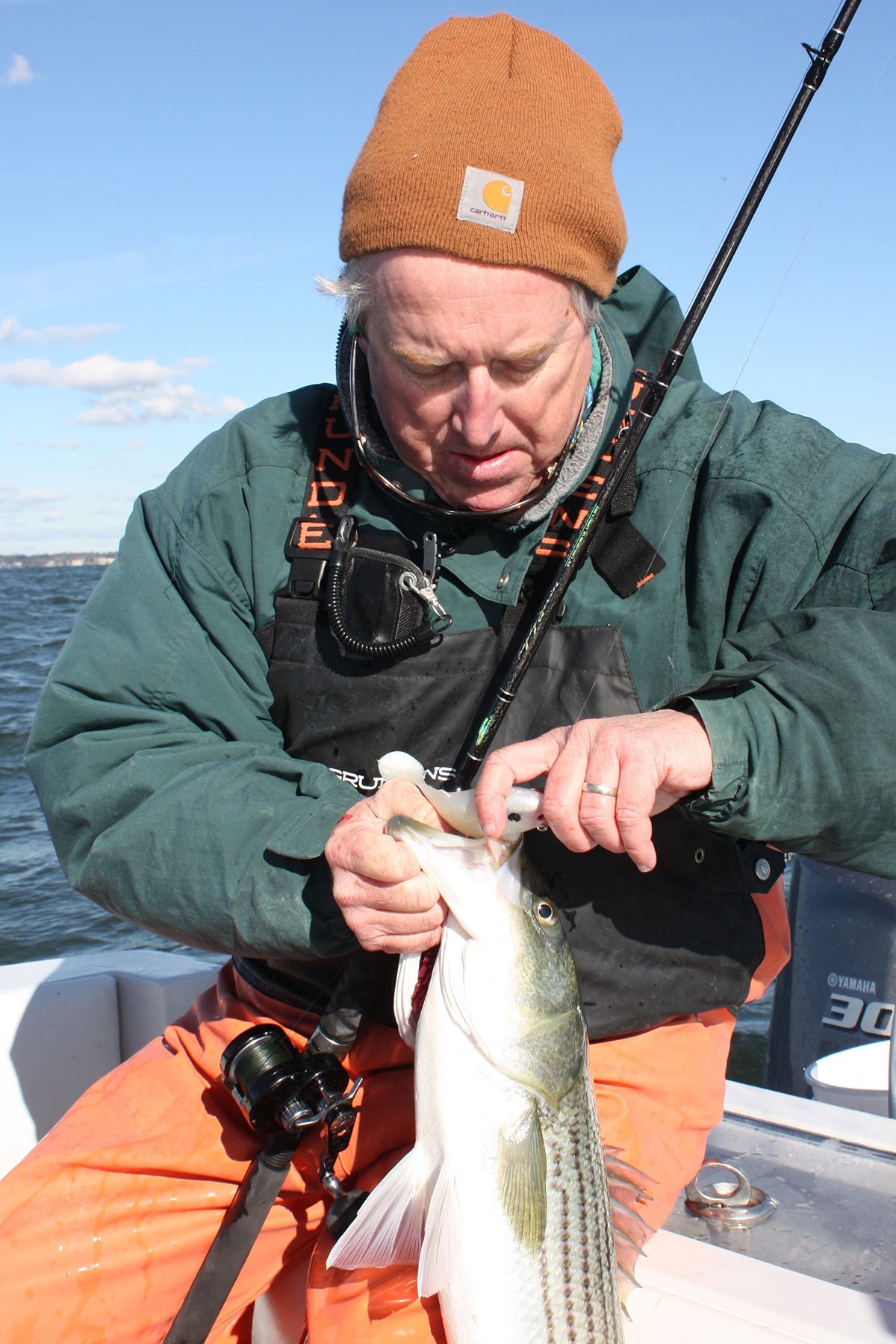
“The first soft plastic we ever used around here was the Jelly Worm,” said Kerry Douton of J&B Tackle of Niantic, CT. “It was always used up in Peconic Bay early in the year for weakfish, especially the grape Jelly Worms.”
Then in 1972, Mister Twister came up with the Curly Tail concept; until that point, wiggly plastic worms were mostly lifeless, the only action provided by the angler himself through jigging the rod or alternating retrieval speed. The new Mister Twister Curly Tail was the first to provide that fluttering action on the retrieve and was quickly embraced by millions of freshwater anglers. Today of course, Pure Fishing’s now legendary Gulp! scents with the “high action swimming tail” of the Gulp! Swimming Mullet is a “must have” on the fluke grounds in the Northeast and Mid-Atlantic.
That Curly Tail concept and silicone-based development was actually patented by the Mister Twister originators who started their hand-poured plastic mold concept in a small shop in Louisiana. By the time the company was bought by Sheldon’s in 1982, competition in this soft plastic arena was booming. The company ultimately released their Sassy Shad paddletail design in the 1980s, the Saltwater Sassy Shad soon after.
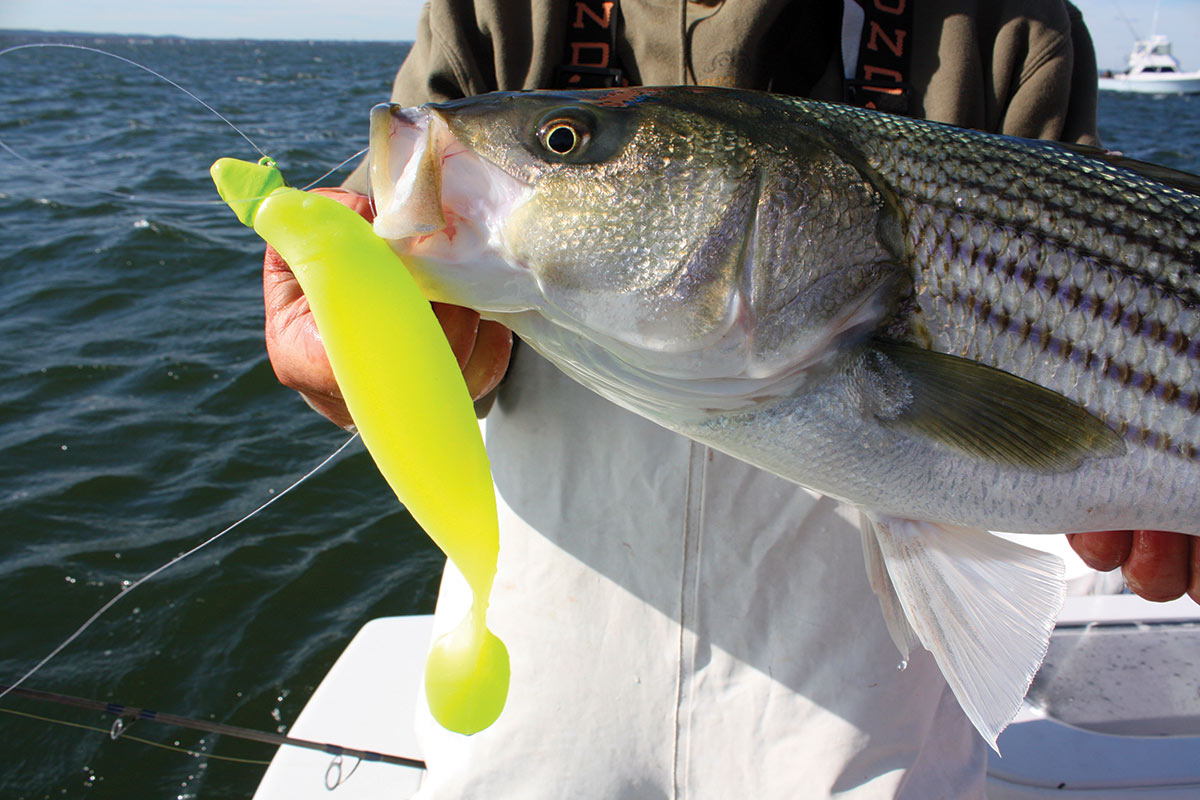
But it was Berkley and the Pure Fishing folks who would ultimately work to address the biodegradability concerns in later years, working on Gulp! and other organic polymers, namely polyvinyl alcohol (PVOH) rather than original polyvinyl chloride (PVC) designs of old. Taking biodegradability a step further, other soft bait manufacturers like Hogy Lures have recently been tinkering with soy based materials in production.
The 1980s also saw the introduction of the Slug-Go in Herb Reed’s Connecticut garage, as the Lunker City Lure company made the first foray from spinner baits and rubber jigs to plastic jerk baits. “The soft stick-bait concept came about when Reed made a few common observations while largemouth were feeding in front of him,” noted Rhode Island’s Capt. Jim White in How To Fish Plastics Baits in Saltwater. Capt. White described the erratic, jerky motion of the Slug-Go as a “natural trigger for gamefish,” and it wasn’t long before Lunker City added a new weakfish standard to local tackle boxes with the release of their split-tail Fin-S Fish.
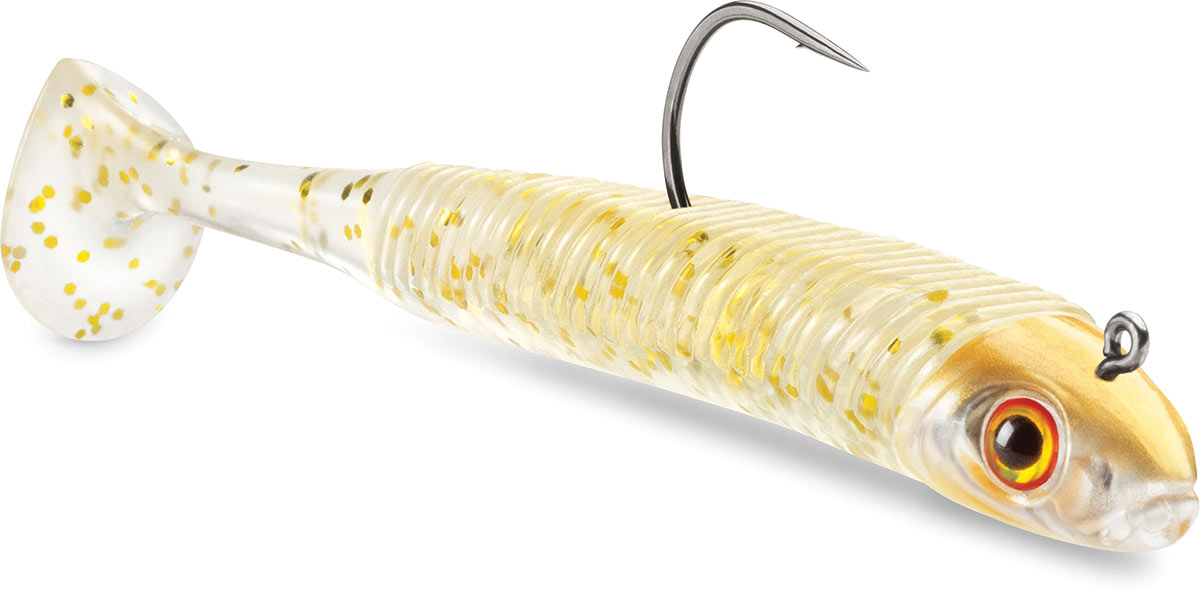
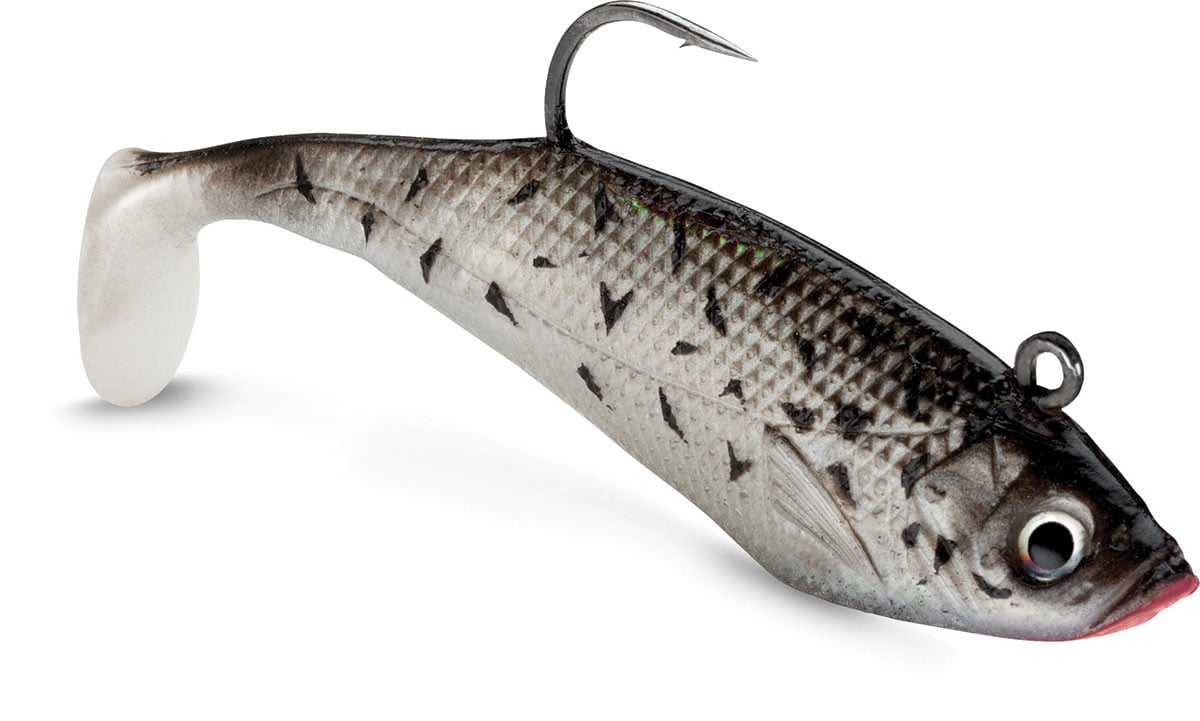
The Conversion Factor
Sometime in the mid ‘90s a buddy handed me a single, pale white shad that he said was a killer on the local jetties. It was devoid of eyes or didn’t have much texture or detail, but it swam beautifully when I rigged it up and cast it out along the rocks for the first time. While it may have been the first I’d seen of a Sassy Shad style bait, it was already being used quite a bit by some of the local bait captains I would meet in subsequent years.
“Had to be the early to mid-1990s, that’s about the time I remember everyone first started using them, even though the old timers were still using the tubes,” said Capt. Gene Nigro of the first forays into umbrella rigs on the Raritan Bay. “There used to be a guy called the Shad Man on Long Island who’d sell to all of the charter guys,” Nigro said, thinking back to the late 1980s and early ‘90s. Wireline trolling had long been a standard practice for the charter fleet in the NY Bight in particular, and while the veterans of the fishery stuck to the sand eel imitations and trolled tubes, others like Nigro began embracing the newer, more realistic shad bodies.
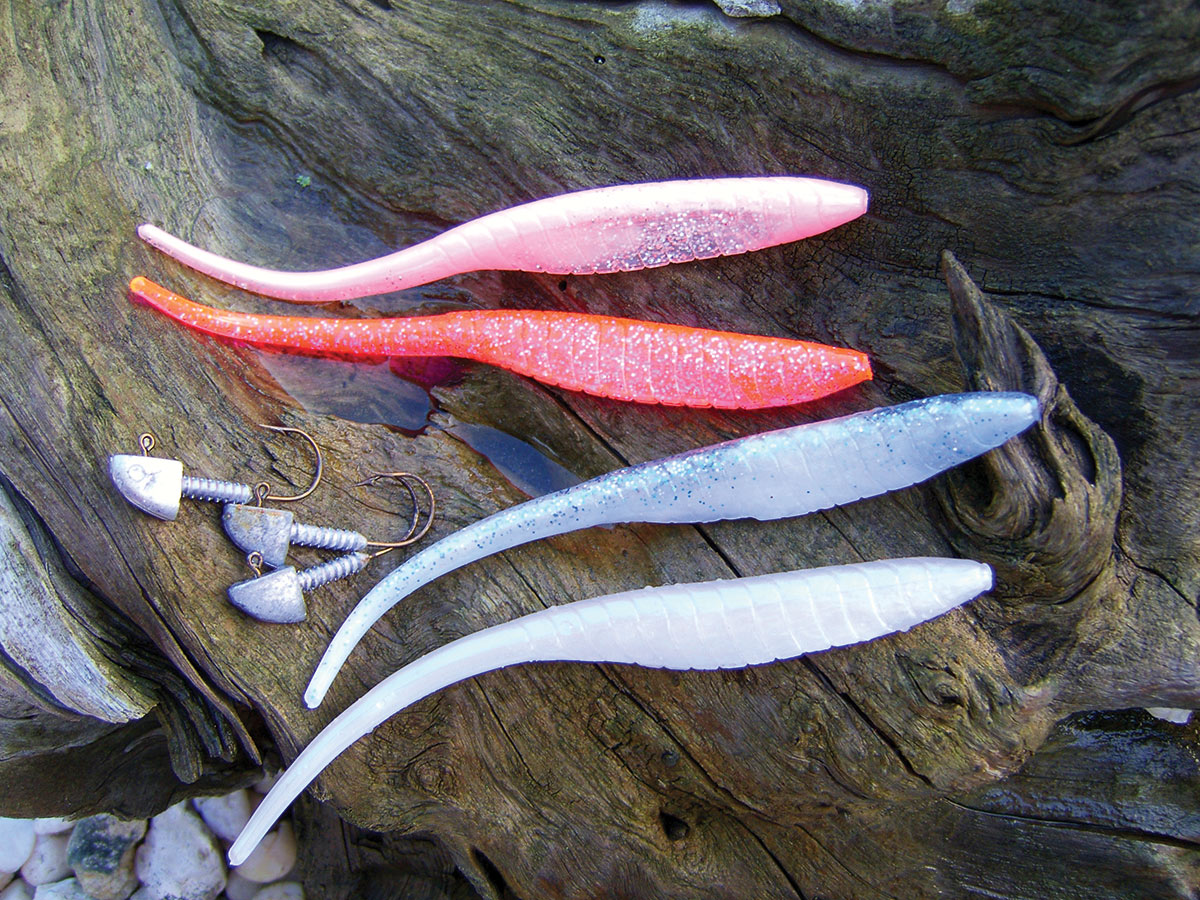
“It was just natural, the fish jumped right on them, especially the 6-inch size, it looked just like a swimming fish,” Nigro said.
It’s interesting to think that one crossover here turned from salt to fresh; true the soft shad bodies originated in the largemouth bass world, but the umbrella rigging concept that was soon popularized by Alabama Rig patent holder Andy Ross in the early 2000s was actually a salty design going back 30 years prior.
“In the ‘70s I started using the umbrella rigs, and then the larger gorilla rigs,” said bunker spoon guru Tony “Maja” Arcabascio, thinking back to times when sand eels were predominant. “We never really caught big fish on them, but we caught a lot of them,” he said.
In the 1990s as smaller herring and bunker were more present, Nigro and Arcabascio both laughed when thinking how the younger generation charter captains turned to the new swim shads for rigging. “The veterans like Freddy Coles, Sr. just laughed at us,” Nigro said.
While swim shads grew more popular for mojo rigging on flat, sandy bottom where no bottom structure exists to snag the heavy bucktail, Douton said the reversed style heads like parachutes, puffers and periwinkles were more popular on the rocky New England waters up off the bottom. “Most of the parachute jigging we do is that straight tail,” noted Dauton, who said when current is heavy or bluefish are present, trolling multi-armed swim shads can be problematic in many areas of Long Island and Block Island Sound.
“The first umbrella rigs that were ever used up here were brought here by John Wadsworth and Ben Rathman,” Douton recollected. “They were the first to use them up here, and they just blew up after that.”
Back to the Future
One of the very first soft plastic lures used by many surfcasters in the day that might often be found on a captain’s umbrella rig was the Felmlee Eel, which was made in the ‘60s right where it’s made today, in Lewiston, PA. Forty or fifty years ago, casters would affix a Felmlee or Ultimus eel to a wobblehead, while occasionally turning to original elver matches of the day created by surf legends Al Reinfelder and Lou Palma (Alou Eel) in the 1960s. These were essentially the artificials to turn to when young guns wanted to prove to their eel-skinning mentors that it was time to turn the page.
In years to follow came new classics like the Al Gag Whip-It Eel, or Don Bingler’s U.S. Patent #3965606 out of Sheepshead Bay, Brooklyn:
“A lure with a weighted head and a tail rotatably secured thereto which gives the optical illusion of a wriggling body. A ball chain swivel extends from the head and a hook is rotatably joined to the ball chain and has a sleeve surrounding at least part of the hook. The construction allows the lure to keep a good horizontal track in the water and also avoids torque twisting the line.”
While technological advances played a part in the ongoing evolution of soft plastics, there was also a crossover in baits. When Storm’s “WildEye” baits hit the market in 2002, surfcasting was going through somewhat of a renaissance. A young of the year spike in striped bass in 1996 coupled with serious restrictions on the industrial bunker reduction fleets brought some of the very best recreational striper fishing in history tight to local beaches, somewhat reducing reliance on natural baits. The first molded plastic paddletails with internal weight systems that many new surfcasters had ever seen, the WildEye became the biggest launch in the history of the Storm brand as it was quickly embraced by a new breed of surfcaster looking to match the hatch in the striper surf.
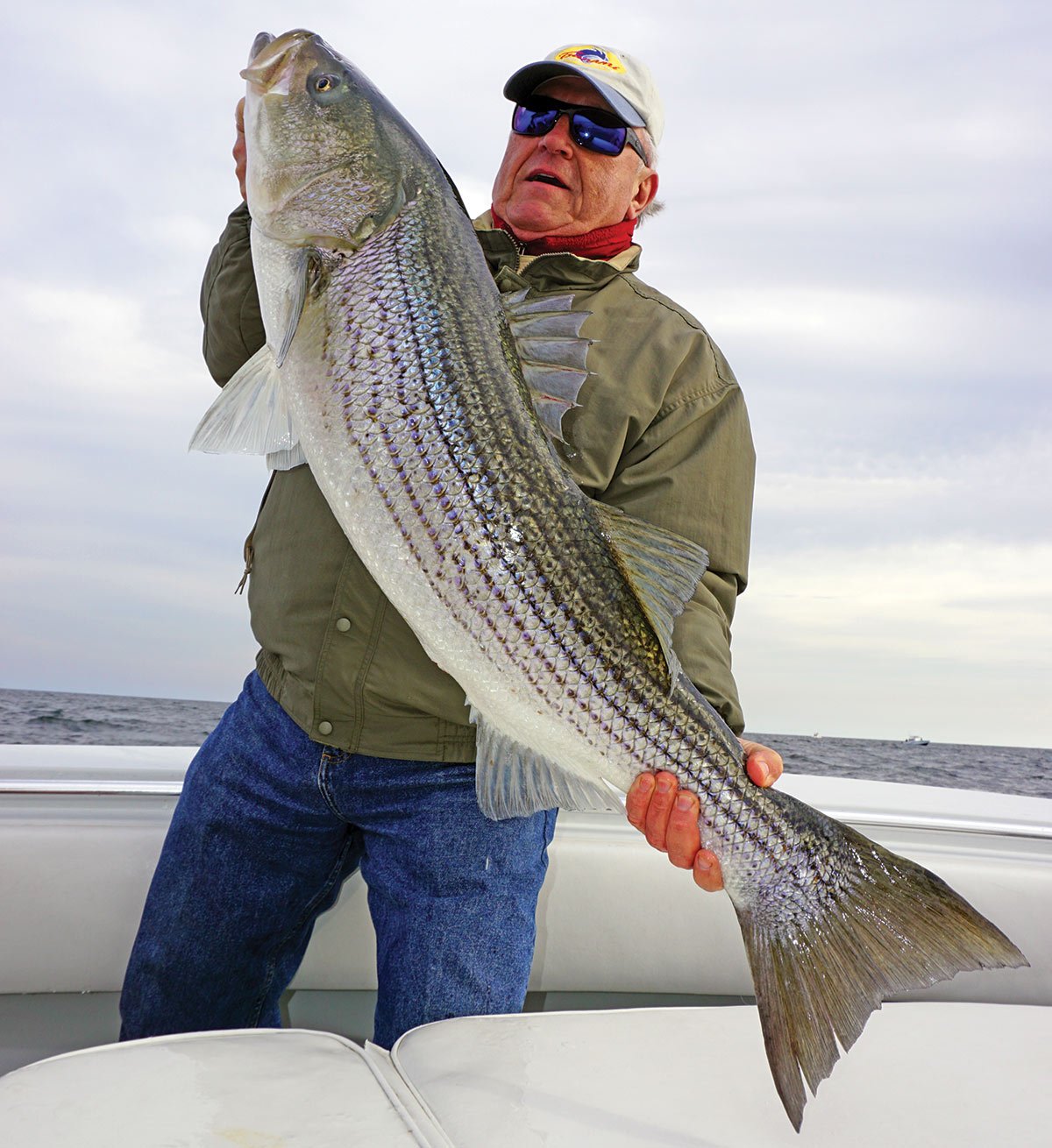
However, these weren’t actually the first of their kind. In fact, one advertising headline from 1958, “The Fish Lure Guaranteed to Catch Fish or it Costs You Nothing,” was how the original Vivif was first introduced by the folks at Panther Martin. Vivif is French for “living minnow” which was exactly what the first Vivif lures were designed to imitate. The originals sported a hand painted body, a flexible fish tail that wiggled when retrieved, and a double hook that pointed downwards; reintroduced to a hungry market in 2004, the Panther Martin Vivif boasts a unique, heart-shaped paddetail, which gives the bait a super realistic swim action that’s castable thanks to the molded weight inside.
This year, the Long Island based Panther Martin folks have brought another freshwater innovation over to the salt with the release of their new 3-in-1 Paddle Tail Weedless Swimbaits and 3-in-1 Eel Tail Weedless Swimbaits, each lure pack containing one rigged swimbait and two spare tails with built-in channels for easy rigging. The jigheads feature two eyelets for jigging or casting, and the design of the hook behind the dorsal keeps the hook itself virtually eel grass free on the retrieve.
Meanwhile Storm has launched a whole new series of ribbed baits called the 360GT Searchbait in 2017; with a big boot tail and PVC body design, the 360GT Searchbait kicks wildly and rolls side-to-side like a distressed minnow and comes matched to an ABS molded jighead complete with internal rattle and VMC coastal black hook. The beauty of the 360GT Searchbait is that it swims like a molded bait, but bodies can be replaced once maimed and mangled from multiple fish.
Along the Striper Coast, Tsunami brand molded plastics have emerged as top selections for casters for their etched holographic foil and transparent fish finishes, with varied weights and sizes for deep jigging or long casts versus smaller, lighter models for light tackle rigging. In terms of realism, the Tsunami weighted Holographic Sand Eels are so authentically detailed that you’d be hard-pressed to pick them out of a lineup in a flat filled with the reel deal.
Bait availability and presence of course being key to both design and implementation in a soft plastics market.
A Big Stretch
While bigger is not always better, it’s essential when trying to match adult baits like bunker, herring or mackerel when trophy gamefish are on the feed. That was the primary mission behind the founding of Hogy Lure Company in 2004, which got its start when Capt. Mike Hogan began making bigger baits for inshore and offshore game. Hogy’s “Original” fast-tapered tail design, up to 14 inches in length, with special channel for more customizable rigging, evolved based on local input; the Hogy DW Long Cast series for example, designed to both mimic larger, wider baits and cast farther with heavier offshore gear required by East Coast anglers looking to throw to blitzing bluefin.
Two years ago, Mann’s Bait Company also got into the big bait market with introduction of its 9-inch Monster Reel N’ Shad, featuring a unique slot design down the centerline of the bait to allow water to move through the body, giving it an enticing, side-to-side swimming action. Other “go to” plastics on the Striper Coast this century in particular include the RonZ and Lunker City’s Slug-Go plastics, baits which can be jerked, twitched, jigged, trolled and sometimes even deadsticked with success.
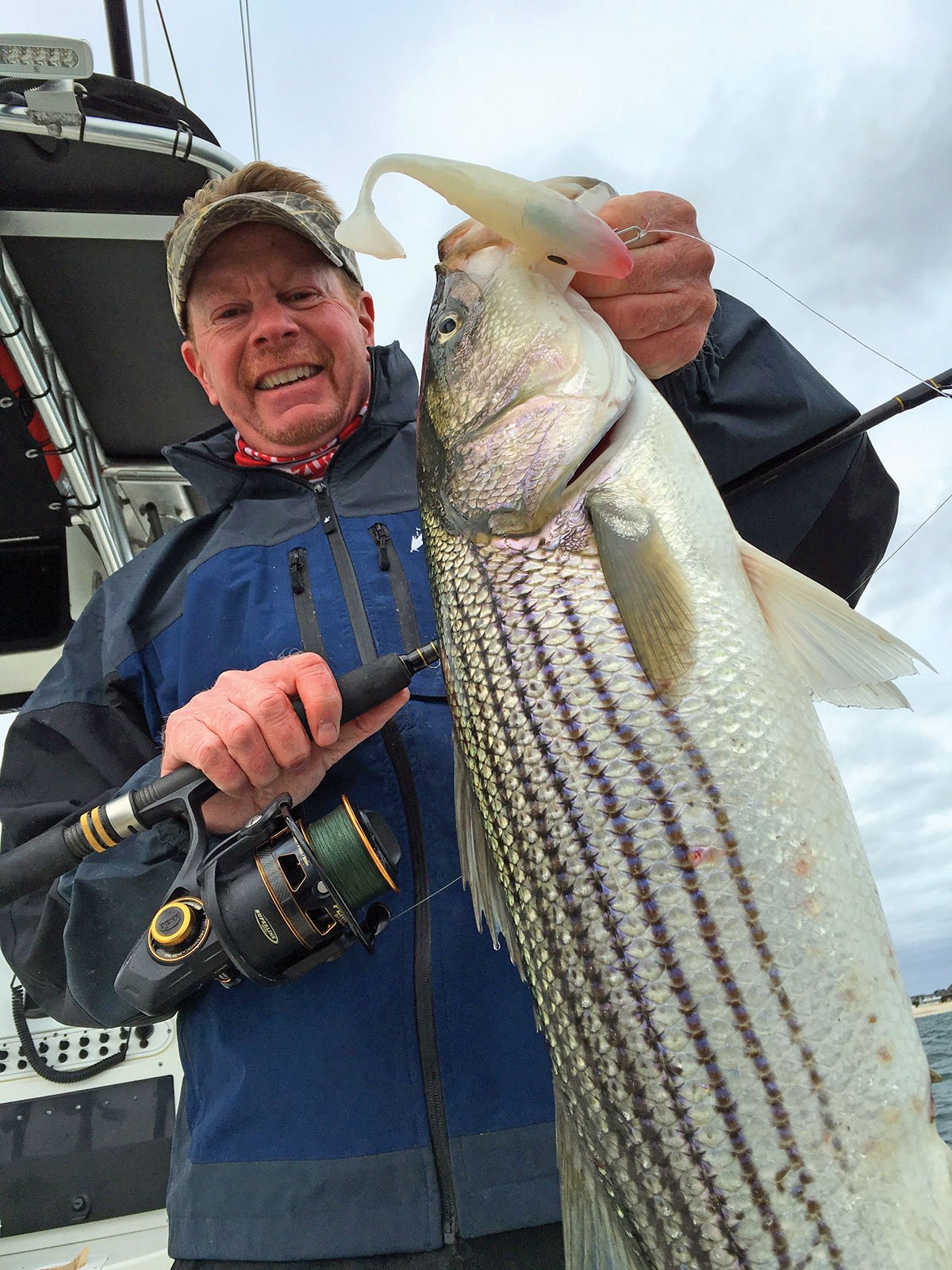
Broader bodied, paddletail baits like unrigged Tsunami shad bodies and Z-Man SwimmerZ are typically fool-proof in terms of effectiveness; a slow, steady retrieve (though alternating a jig here and there can often elicit savage strikes) to mimic swimming bunker makes them deadly on stripers. On the other hand, saltwater jerk baits like the Fin-S, Bass Kandy Delights (BKD), Bass Assassin Zooms, and Berkley PowerBait Saltwater Jerk Shads are often best retrieved with a twitch or two or twenty, as the herky jerky style of those tapered tail baits provides more of a match to darting baits like spearing.
When rigging loose plastics on your favorite jighead, it’s good to have a full complement of shapes and styles to match your varied color options; same rings true with the jigheads themselves. And above all else, always be on the lookout for new or unfamiliar items on pegboards at your local shop. Ribbed baits for example have gained quite a few converts in recent years; with peanut bunker being just like candy to stripers and weakfish, seek out some of the next generation paddletail baits like the Keitech Swing Impact, Berkley Powerbait Rib Shads, Storm’s new Searchbaits, Lunker City’s Swimming Ribster and most recently the Kettle Creek Outfitters “Swing Shads” out of New Jersey, which use a dose of infused anise as added fish attractant.
“There’s a great future in plastics,” is what Mr. McGuire advised the Graduate, Ben Braddock, over 50 years ago on the big screen; Atlantic coastal anglers remain ever-hopeful of this continuing evolution in the world of sportfishing.
| TACKLE TIP: STORING BAITS |
|---|
|
The show season from January through March is especially an enjoyable time for me as I sneak from The Fisherman booth periodically to look for plastics to gather up for the season ahead. Just before the spring kickoff, I like to gather up loose plastics to combine in a heavy-duty Ziploc bag, which I heavily dose with natural scents, specifically Fin-Essence Shedder Crab oil, a rather sweet and sticky extract of shedder or peeler crab. If your local shop doesn’t have it, look for it online. It comes in 3-ounce containers that I squeeze into my bag full of plastics every spring to allow it to permeate with my plastics. One important reminder – before you go mixing together all of your newly purchased plastics in one giant bag or tackle container, keep in mind that some plastics don’t get along with others. For example, Z-Man’s proprietary ElaZtech material is super soft and ultra tough; it also contains no PVC, plastisol or phthalates, making the baits effectively non-toxic. But storing these baits together with their PVC counterparts will lead to a melted glob of goo in relatively short time. Be careful storing super-soft and ultra-pliable baits with other standard plastics; if they feel significantly different in your fingers, best to keep ‘em separated. – JH |


